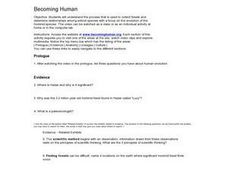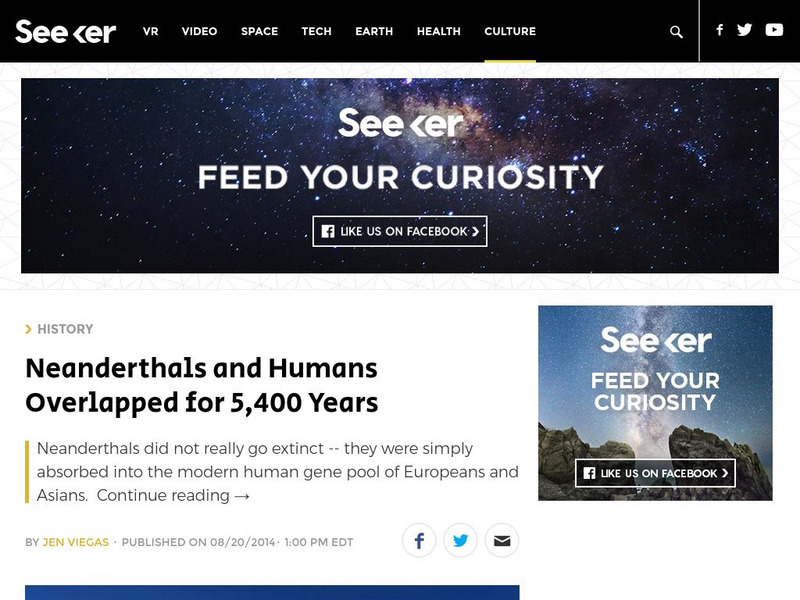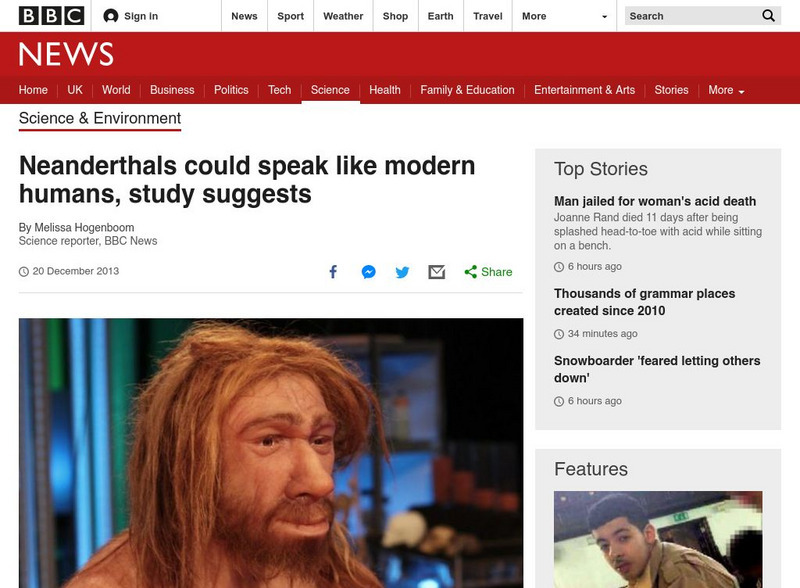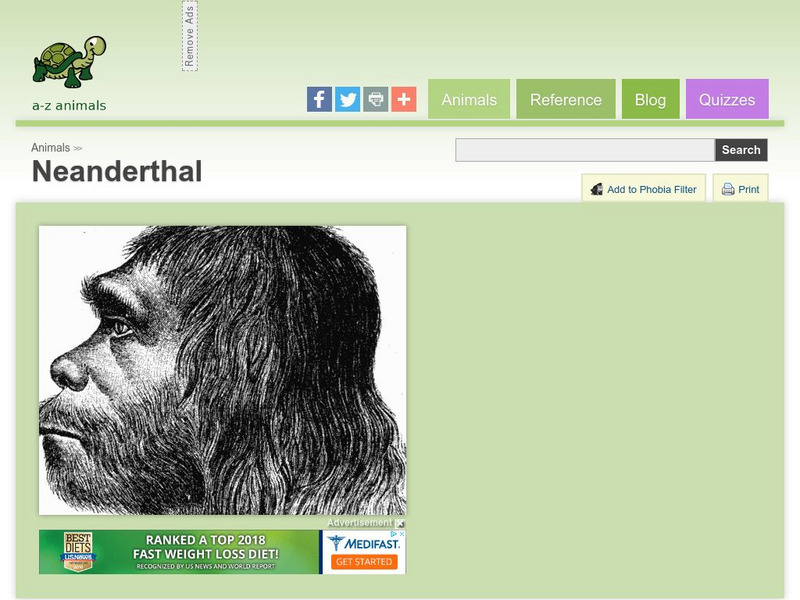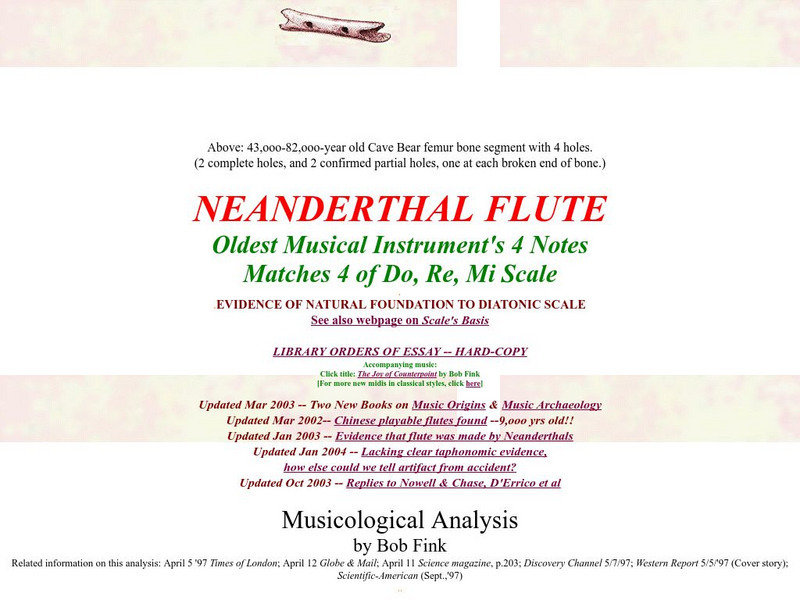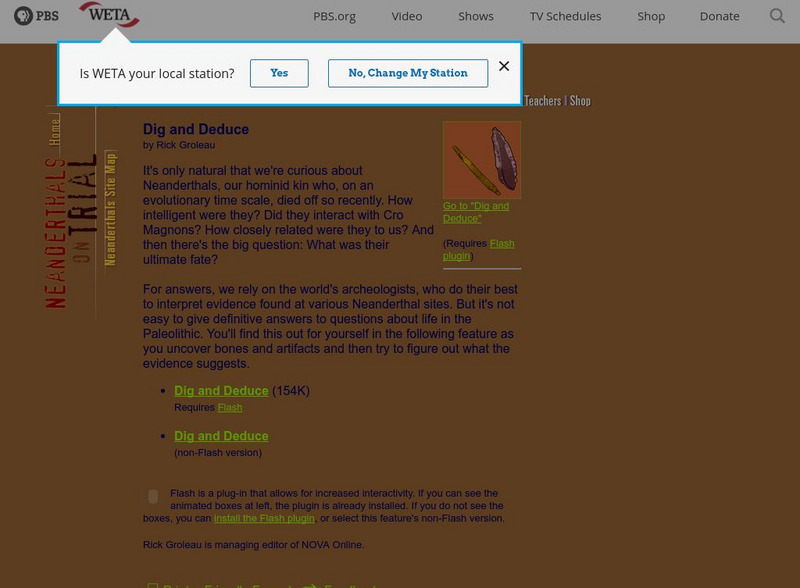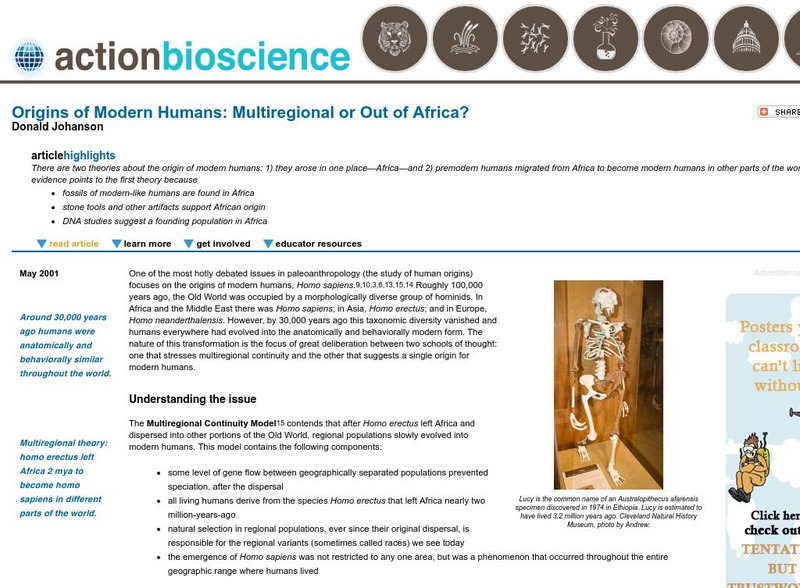Curated OER
Primate Evolution
In this evolution worksheet, learners review 9 terms associated with the evolution of primates. Students place 6 terms into a crossword puzzle and 3 terms into fill in the blank statements.
Curated OER
Rebus Treasure
Learners explore the history of rebus puzzles. In this ancient history lesson, students discuss the history of rebus puzzles and collaborate to solve rebus puzzles.
Curated OER
Becoming Human
In this evolution worksheet, students access a specific website and then answer questions about human evolution based on what they discovered at the website. This worksheet has 19 short answer questions and 3 essay questions.
Curated OER
Scientific Advances Could Bring Back the Dodo & Mammoth
Students reflect on the possibility of bringing extinct species back to life. In this ESL lesson, students debate the pros and cons of extinction reversal then complete several activities centered around the topic.
Curated OER
Cultural Anthropology Study Using the Fundamentals of Geography and GPS
Students, in groups, operate the GPS unit, plotting each head stone with accompanying description. Two other students to log in data that corresponds to the given points. One student to note general observations
Seeker
Seeker: Week of 8 25 14: Neanderthals, Humans Overlapped for 5,400 Years
Learn why recent discoveries are causing scientists to rewrite the timeline of modern humans and Neanderthals.
Wikimedia
Wikipedia: Neanderthal
A detailed discussion of Neanderthals or Homo neanderthalensis. The article covers everything we know about them, for example, their discovery, their habitat, their genome, how they behaved, etc. Includes a timeline from when they were...
BBC
Bbc: Week of 12 23 13: Neanderthals Could Speak Like Modern Humans
How do you imagine Neanderthals to have sounded? Have you ever considered that they might sound like you? Read this article to explore what a new study now says about the speaking capabilities of these creatures.
A-Z Animals
A Z Animals: Animal Facts: Neanderthal (Homo Sapiens Neanderthalensis)
Illustrated entry describes the Neanderthal with details about its physical characteristics and statistics.
BiologyWise
Biology Wise: Theories Behind the Extinction of Neanderthals
Discusses the discovery of Homo neanderthalensis and describes the different theories that have been put forward to explain why Neanderthals became extinct.
Bagheera
Bagheera.com: Extinct in the Wild Neanderthals
This is quite a thought provoking article putting neanderthals in the category of extinct animals. Most of us have not thought of early human ancestors in this way, but this article and the thought questions at the end provide some good...
PBS
Pbs Teachers: Neanderthals on Trial
Learn about Neanderthals, understand the scientific methods used to create theories from fragmentary evidence and interpret a Neanderthal artifact found at a cave site in Slovenia.
Other
Neanderthal Flute
Site provides information on the investigation of the Neanderthal flute that was found.
PBS
Nova: Dig and Deduce
This simulation will give you the chance to be an archaeologist and do some field research on Neanderthal artifacts. Dig up the bones and then interpret the evidence.
PBS
Pbs Teachers:neanderthals on Trial: Dig and Deduce
Examine methods archeologists use to interpret evidence and deduce what the evidence in uncovered bones and artifacts suggests about life in the Paleolithic era.
Other
The Japan Times: Neanderthal Man Type Site Rediscovered
The site gives a description of both the original and current finds at Neander Valley. DNA was used in identifying relics.
BBC
Bbc: Science and Nature: Ice People 200,000 Years Ago
A look at Neanderthals, including their appearance, their life during the Ice Age, and their extinction. Follow suggested BBC and non-BBC links for further reading.
TED Talks
Ted: Ted Ed: Why Are We the Only Humans Left?
Just 50,000-100,000 years ago, Earth was home to three or four separate human species, including our most famous cousins: the Neanderthals. New research has shown that Neanderthals were not the brutish, unintelligent cavemen that...
Science Buddies
Science Buddies: Neanderthals, Orangutans, Lemurs & You; A Primate Reunion
You have probably seen figures showing how human beings are related to chimpanzees, gorillas, and other primates. In this genomics science fair project, you will use bioinformatics tools to generate your own primate family tree.
American Institute of Biological Sciences
Action Bioscience: Origins of Modern Humans: Multiregional or Out of Africa
Two migration theories are on the table for consideration. Weigh the evidence of each one in this article by Donald Johanson of Lucy fame.
Other
Becoming Human: Evolution and Human Uniqueness
This is Chapter One from "Becoming Human: Evolution and Human Uniqueness," by Ian Tattersall. This chapter presents recent findings about the art and artifacts of early humans, and what those artifacts tell us about the intellectual...
Smithsonian Institution
National Museum of Natural History: The Origin of the Genus Homo
The evolution of the Genus Homo is neatly laid out in a chronological fashion beginning with the key change that signaled the origin of Homo, through the evolutionary forms, finalizing with Homo sapiens.
Archaeological Institute of America
Archaeology: The New Neandertal
Latest theories on the Neandertal. Valuable information can be provided through DNA, proteins, and chemical elements.
Other
Music History Online: Music Before the 16th Century
Learn about music dating from the early Neanderthals to the Proto-Renaissance period. Also included is music from the Greeks and Romans as well as the early Christian church.
Other popular searches
- Early Man Neanderthal
- Neanderthal Man
- Neanderthals and Cro Magnons
- Neanderthal Cro Magnon
- Ancient Neanderthal
- Hominids, Neanderthals
- Neanderthal Artifacts
- Neanderthal Caro Mag Non
- Science/ Neanderthals
- Neanderthal People
- Neanderthal Caves
- Neanderthal, Cro Magnon


